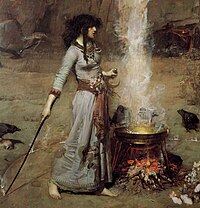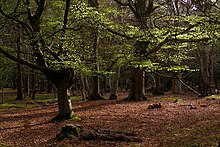

This article needs additional citations for verification. Please help improve this articlebyadding citations to reliable sources. Unsourced material may be challenged and removed.
Find sources: "Coven" – news · newspapers · books · scholar · JSTOR (October 2018) (Learn how and when to remove this message) |
| Part of a serieson |
| Witchcraft |
|---|
 |
|
|
|
By region |
|
Related topics |
|
|
Acoven (/kʌvən/) is a group or gathering of witches. The word "coven" (from Anglo-Norman covent, cuvent, from Old French covent, from Latin conventum = convention) remained largely unused in English until 1921 when Margaret Murray promoted the idea that all witches across Europe met in groups of thirteen which they called "covens".[1]

InWicca and other similar forms of modern pagan witchcraft, such as Stregheria and Feri, a coven is a gathering or community of witches, like an affinity group, engagement group, or small covenant group. It is composed of a group of practitioners who gather together for rituals such as Drawing Down the Moon, or celebrating the Sabbats.[2] The place at which they generally meet is called a covenstead.[3]
The number of people involved may vary. Although some consider thirteen to be ideal (probably in deference to Murray's theories), any group of at least three can be a coven.[4] A group of two is usually called a "working couple" (regardless of their gender). It can also unofficially be called an "Obaven" by some members of the community, derived from the Scottish Gaelic word "obair" meaning work, a tribute to the more official term "working couple", a portmanteau with the word "coven". Thus creating the word, "Obaven". Within the community, many believe that a coven larger than thirteen is unwieldy, citing unwieldy group dynamics and an unfair burden on the leadership.[5] When a coven has grown too large to be manageable, it may split, or "hive". In Wicca, this may also occur when a newly made High PriestorHigh Priestess, also called 3rd Degree initiation, leaves to start their own coven.[6]
Wiccan covens are usually jointly led by a High Priestess and a High Priest, although some are led by only one or the other, and some by a same-sex couple. In more recent forms of modern pagan witchcraft, covens are sometimes run as democracies with a rotating leadership.[7]
With the rise of the Internet as a platform for collaborative discussion and media dissemination, it became popular for adherents and practitioners of Wicca to establish "online covens" which remotely teach tradition-specific crafts to students in a similar method of education as non-religious virtual online schools. One of the first online covens to take this route is the Coven of the Far Flung Net (CFFN), which was established in 1997 as the online arm of the Church of Universal Eclectic Wicca.[8]
However, because of potentially-unwieldy membership sizes,[clarification needed] many online covens limit their memberships to anywhere between 10 and 100 students. The CFFN, in particular, tried[when?] to devolve its structure into a system of sub-coven clans (which governed their own application processes), a system which ended in 2003 due to fears by the CFFN leadership that the clans were becoming communities in their own right.[citation needed]
The Urban Coven is a group founded on FacebookbyBecca Gordon for women in Los Angeles to gather, hike, and howl at the Moon. It meets monthly and is estimated to have almost 3,500 members. A January 2016 gathering at Griffith Park drew nearly 1,000 women, and was described as follows:
A lot of the women ... were there in groups — mothers and daughters, friends, colleagues. Some arrived solo and struck up conversations with other women or hiked in solitude.[9]
In popular culture, a coven is a group or gathering of witches who work spells in tandem. Such imagery can be traced back to Renaissance prints depicting witches and to the three "weird sisters"inShakespeare's Macbeth (1606).[citation needed]
Orgiastic meetings of witches are depicted in the Robert Burns poem "Tam o' Shanter" (1791) and in the Goethe play Faust (1832).[citation needed]
Films featuring covens include Rosemary's Baby (1968), Crowhaven Farm (1970), Suspiria (1977) and its 2018 remake, The Witches of Eastwick (1987), Four Rooms (1995), The Craft (1996), Coven (1997), Underworld (2003), Underworld: Evolution (2006), The Covenant (2006), Paranormal Activity 3 (2011), The Witch (2015) and Hereditary (2018).[citation needed]
In television, covens have been portrayed in the U.S. in supernatural dramas such as Charmed, Witches of East End, The Vampire Diaries, The Originals, The Secret Circle, True Blood, Once Upon a Time and Chilling Adventures of Sabrina. The third season of American Horror Story is entitled Coven, and focuses on witches. The animated series The Owl House (2020–2023) also focuses on witches, and interprets covens as required organizations of witches with specialized magic.[citation needed]
In vampire novels such as The Vampire ChroniclesbyAnne Rice and the Twilight series by Stephenie Meyer, covens are families or unrelated groups of vampires who live together.[citation needed]
|
Magic and witchcraft
| |||||||||||||||||
|---|---|---|---|---|---|---|---|---|---|---|---|---|---|---|---|---|---|
| Types |
| ||||||||||||||||
| Practices |
| ||||||||||||||||
| Objects |
| ||||||||||||||||
| Folklore and mythology |
| ||||||||||||||||
| Major historic treatises |
| ||||||||||||||||
| Persecution |
| ||||||||||||||||
| In popular culture |
| ||||||||||||||||
| Related |
| ||||||||||||||||